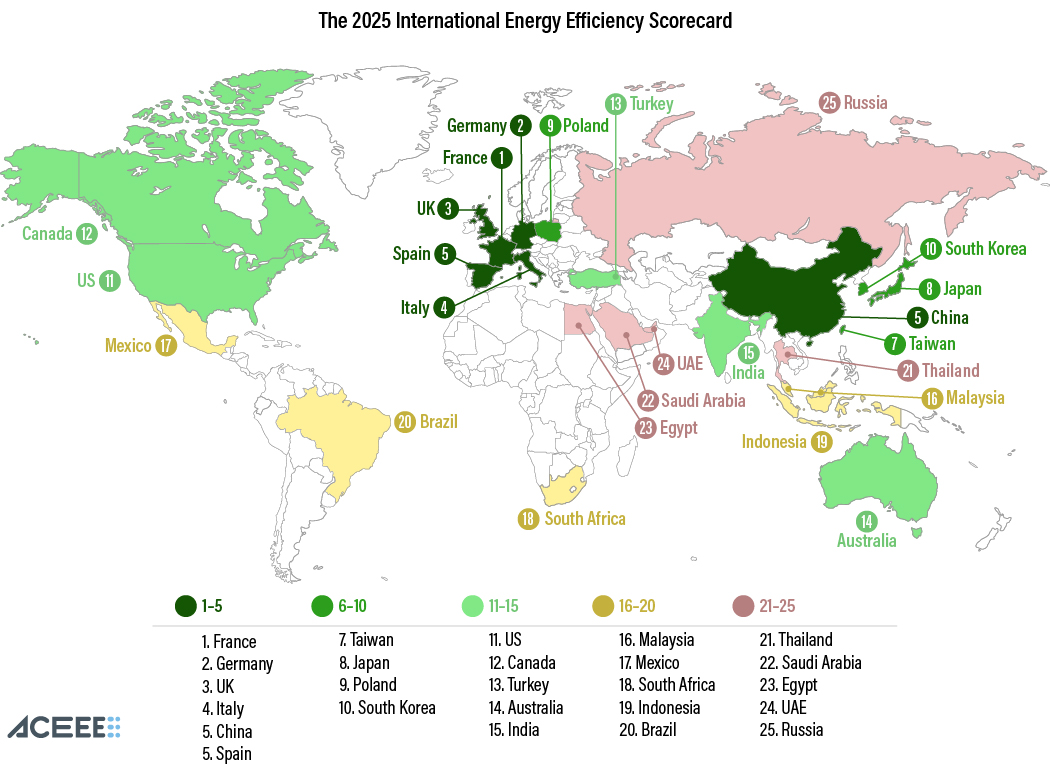France ranks #1 again, China moves up to #5, U.S. drops to #11
The world’s largest energy users are making limited progress on reducing energy use and climate emissions through energy efficiency improvements, according to a new scorecard from the American Council for an Energy-Efficient Economy (ACEEE). ACEEE’s International Energy Efficiency Scorecard ranks the 25 countries with the highest energy use on their energy efficiency policies and performance. Since the previous scorecard in 2022, most countries have made only incremental improvements, with the global average score rising just 4.5 points, to 53 of 100.
Read the Scorecard France once again topped the International Scorecard, earning 85.5 out of 100 possible points. It earned the highest score in the industry and transportation chapters due to low industrial energy intensity, stringent fuel economy standards, and other ambitious policies. France also has building codes that require energy-efficiency upgrades during residential and commercial building renovations, and it provides financial incentives for the energy upgrades. France was followed by Germany (#2), the United Kingdom (#3), Italy (#4), and China and Spain (tied for #5).
China was the most improved country, earning 15 more points and rising four spots compared to its 2022 score. China leads in both public transit use and EV adoption and is one of only two countries to have national targets for reducing energy consumption and energy intensity. The United States ranked #11, after ranking #10 in the previous scorecard. The lowest-ranked countries were Egypt, the United Arab Emirates, and Russia, whose scores were affected by their limited data availability.
The limited progress comes even after more than 130 countries, including a large majority of those evaluated in the scorecard, pledged at the 2023 United Nations climate conference to collectively double the global average annual rate of energy efficiency improvements from around 2% to more than 4%. The contrast between the pledge and national policies highlights the need for countries to make more substantial efforts to save energy.
“Energy efficiency is one of the fastest, most affordable ways to cut climate pollution, but most countries are only taking incremental steps when bold action is needed,” said Jasmine Mah, senior research analyst at ACEEE and lead author of the International Scorecard. “Without stronger policies and performance, countries across the globe risk higher energy bills, greater dependence on fossil fuels, and failure to meet their climate targets.”
Even top-ranked nations have significant room for improvement, particularly on transportation, where nearly every country evaluated continues to rely heavily on personal vehicles and fossil fuels. Across most countries, public transit use remains low while vehicle miles/kilometers traveled remain high. Only three countries—Italy, France, and the United Kingdom—invest more in rail than roads, and just over half have national policies that encourage walking and cycling.
Energy-efficient buildings are essential to reduce emissions, but only four countries—France, Germany, Italy, and the United Kingdom—require efficiency upgrades during renovations and offer incentives for retrofits. Efficiency standards for appliances are another crucial strategy for lowering household energy use and helping consumers save money on energy bills. Most countries lack comprehensive standards and can benefit from enacting minimum efficiency standards for more types of appliances.
In the industrial sector, most countries have yet to adopt comprehensive policies to curb energy waste. Less than half require large industrial facilities to hire onsite energy use managers or sustainability experts. Although most countries have national targets for industrial decarbonization, only nine have goals to advance industrial electrification. Most countries invest less than 10% of their industrial sector spending in industrial research and development; greater investments could lead to innovations in energy-saving technologies and further decarbonization of industry.
All the European Union (EU) countries featured in the scorecard (France, Germany, Italy, Poland, and Spain) ranked in the top 10. The EU has passed ambitious policies like the Energy Efficiency Directive and the European Green Deal that urge all member states to prioritize energy efficiency. As a result, the EU countries earned points for having common policies like minimum performance standards and mandatory labels for appliances as well as stringent fuel economy standards for heavy-duty vehicles.
Outside Europe, the four East Asian countries evaluated (China, Japan, South Korea, and Taiwan) scored highly, particularly in the industry chapter. These countries require energy audits of large industrial facilities and have voluntary agreements with manufacturers to make efficiency improvements. All four have national climate and energy efficiency goals.
To accelerate progress, the scorecard recommends that countries adopt national targets to save energy across sectors, strengthen building codes and appliance standards, require onsite energy managers and audits for large industrial facilities, and prioritize public transit, walking, and cycling over private vehicle use. These steps can help nations meet climate goals, cut costs for households and businesses, and build more resilient energy systems.
Accompanying the scorecard are fact sheets on each country evaluated, showing their progress and recommendations for improvement.

